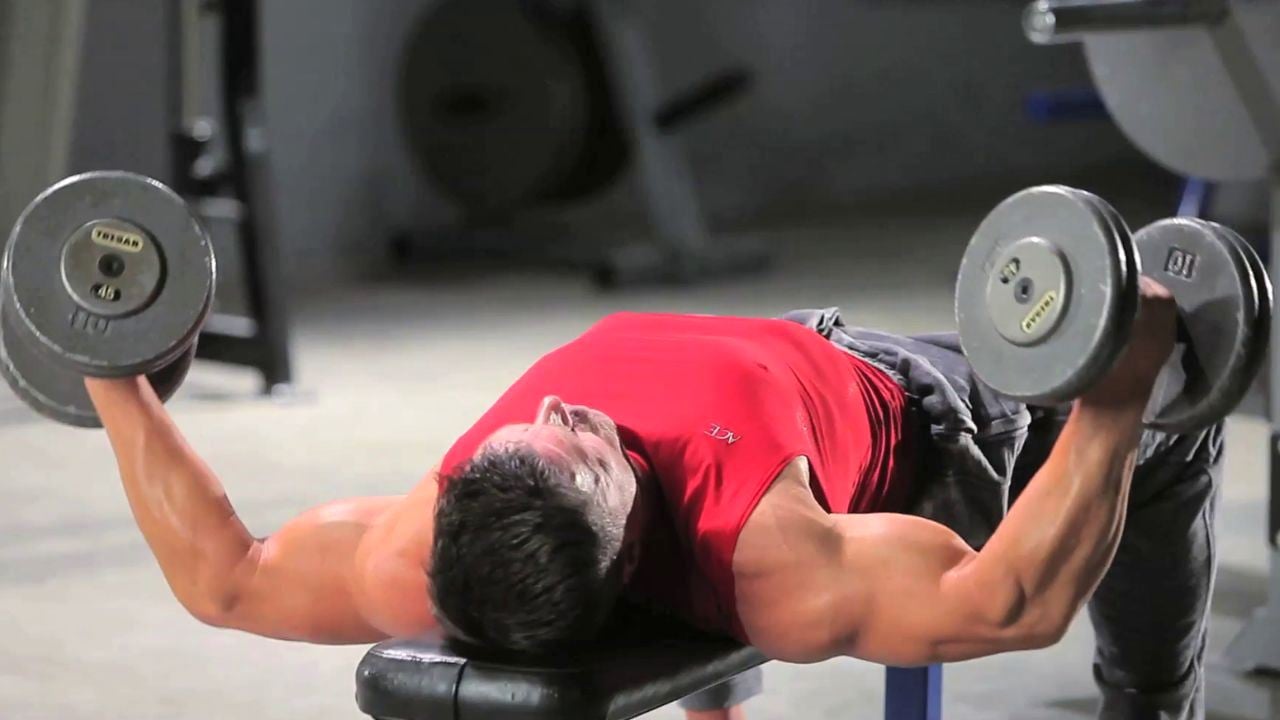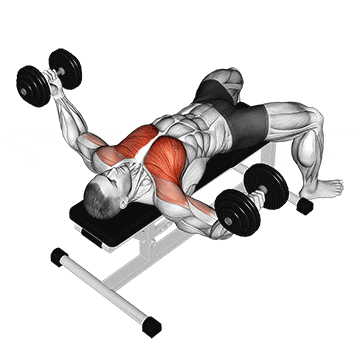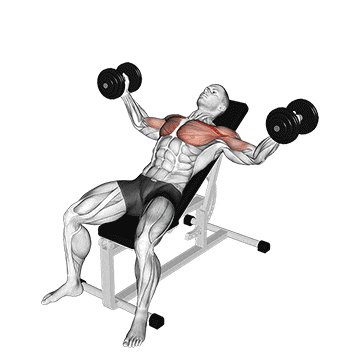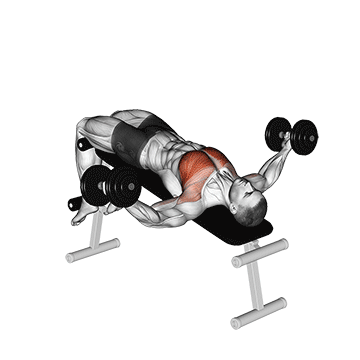If you want to build a bigger and better-shaped chest, dumbbell chest fly are a must-have addition to your chest workout routine.
The dumbbell fly is a bodybuilding favorite and a chest isolation exercise, usually performed after big compound lifts, such as the barbell press and incline bench press.
They are considered the perfect finishing move and a great way to focus on your chest after pressing exercises.
You can do the standard dumbbell fly by lying on a bench. But if you do the same exercise on an incline or decline bench, you will shift the focus more on your upper and lower chest muscles.
A Lying dumbbell fly is the simplest way to perform a chest fly, though the exercise can also be performed using a cable machine. They can be performed supine, sitting, or standing upright.
Don’t WORRY. This comprehensive guide will give you everything you need to know about them.

- Dumbbell Chest Fly Muscles Worked
- How To Do Dumbbell Chest Fly
- Dumbbell Chest Fly Form and Technique
- Best Variations Of Chest Dumbbell Fly
- 1. Incline Dumbbell Fly
- 2. Decline Dumbbell Fly
- 3. Standing Upward Dumbbell Chest Fly
- Benefits of Chest Dumbbell Fly
- FAQ
- Are dumbbell chest flys good?
- Are standing dumbbell flys good for chest?
- What muscles do dumbbell chest flys work?
- Takeaway
- Resources
Dumbbell Chest Fly Muscles Worked
- Primary Muscles: Chest (Pectoralis Major)
- Secondary Muscles: Anterior Deltoid and Coracobrachialis
- Stabilization Muscles: Biceps Brachii, Serratus Anterior, Rotator Cuff Muscles, Trapezius and Rhomboids

How To Do Dumbbell Chest Fly
Follow these step-by-step instructions to ensure you do it right and get the most out of it.
- Lie flat on a bench with your feet firmly planted on the ground.
- Hold a dumbbell in each hand with a neutral grip (palms facing each other).
- Hold the dumbbells directly above your chest in a neutral grip, with your arms almost straight.
- Slowly lower the dumbbells out to the sides in a wide arc, while maintaining a slight bend in your elbows.
- Keep lowering the dumbbells until your arms are parallel to the ground or slightly below the ground, and you feel a stretch in your chest muscles.
- At the bottom of the movement, focus on the contraction in your chest.
- Use your chest muscles to lift the dumbbells back up to where you started.
- Do 8–12 Reps and 3–4 sets

Dumbbell Chest Fly Form and Technique
- As a beginner, you should start with a light set of dumbbells and gradually increase the weight each week as you build strength.
- When you reach the top, don’t let the dumbbells touch. Hold for a second in the contracted position.
- Keep your elbows bent. You should never fully straighten your arms or lock them out, as this forces the weight you lift onto the elbows and shoulder joints, increasing your chance of injury.
- Don’t let your elbows drop too far when you’re in the start position; they should remain in line with your torso when you’re lying on the bench.
- Avoid using momentum or swinging your arms when lifting the dumbbells. Slow and deliberate motions engage the chest muscles more effectively.
- Maintain control. After a 4-second descent, pause slightly, contract with a reverse motion, hold, and repeat.
- Pick a weight that you can control, that’s not too light or heavy — find what’s right for you.
- Maintain tension in your abs, and don’t allow your lower back to excessively arch.
Best Variations Of Chest Dumbbell Fly
The dumbbell fly can be done differently to suit your fitness level.
- If you are a beginner, you may want to apply a few modifications to make it easier. One way to achieve this is to do dumbbell flies on a flat bench or by using a lighter weight.
- If you are looking for a more advanced variation to stimulate different muscle fibers in the chest, try the incline dumbbell fly, decline dumbbell fly, and stand upward chest fly.
- You can adjust the bench angle and use heavier weights to make it more challenging. But please focus on form while you’re doing it.
1. Incline Dumbbell Fly
The incline dumbbell fly is a variation of the dumbbell fly exercise that specifically targets the upper chest muscles (pectoralis major) while also engaging the shoulders and triceps.
Performing dumbbell fly exercise on an inclined bench changes the angle of movement and places greater emphasis on the upper chest area.

How To Do Incline Dumbbell Fly
- Set an incline bench at a 30-to 45 degree angle. Do not go more upright as the stress shifts to the shoulders rather than the chest area.
- Lie on the bench with your feet flat on the floor. Keep your shoulder blades retracted and depressed throughout the movement.
- Hold a dumbbell in each hand with a neutral grip (palms facing each other)
- Lift your arms straight up from your shoulders and the dumbbells directly over your upper chest.
- Slowly lower your arms to your sides until your wrists reach shoulder level or slightly above.
- Bring your arms back toward the midline of your body, focusing on using your pec muscles to draw them back together.
2. Decline Dumbbell Fly
The decline dumbbell fly is another variation of the dumbbell fly exercise that targets the lower portion of the chest muscles (pectoralis major).
Performing the chest dumbbell fly on a decline bench engages the lower chest muscles more deeply, stimulating muscle growth and strength in that area.

How To Do Decline Dumbbell Fly
- Set a decline bench at an angle of about 20-25 degrees.
- Lie back on the bench with your head positioned at the lower end.
- Secure your feet in the foot pads or anchor them under a stable surface.
- Hold a dumbbell in each hand with a neutral grip (palms facing each other). Extend the dumbbells above your chest.
- Lower the dumbbells to the sides in a wide arc. Try to feel the stretch in your lower chest muscles.
- Move your arms back to the middle of your body and use your pec muscles.
3. Standing Upward Dumbbell Chest Fly
Standing dumbbell chest fly is a good exercise to target your upper chest. With only a pair of dumbbells, you can make your chest area broader and more developed.
Since the exercise involves lifting the dumbbells up while standing, it also works the anterior deltoids and core muscles for stability.

How To Do Standing Upward Chest Fly
- Stand upright with your feet shoulder-width apart and hold a dumbbell in each hand with a neutral grip.
- The dumbbells should be at your sides.
- Lift both dumbbells in an arc motion in front of you.
- Continue raising the dumbbells until your arms parallel the ground or slightly above.
- Pause at the top of the movement and focus on squeezing your upper chest muscles.
- Slowly lower the dumbbells back down to the starting position, maintaining control throughout the motion.
Benefits of Chest Dumbbell Fly
- Unlike compound exercises like bench press, dumbbell flyes isolate the pecs (chest muscles) and allow for focused development.
- The dumbbell chest fly can help open up your chest muscles. Chest openers may help reduce upper back pain, increase range of motion, and reduce tightness in the upper body.
- The wider range of motion in dumbbell fly compared to bench press allows for a deeper stretch and contraction of the pecs.
- A stronger chest will enhance your physique, help you with daily activities, and improve your sporting performance.
- The dumbbell fly doesn’t require much equipment. If you don’t have a bench, you can do it while lying on the floor.
- The dumbbell fly may put less strain on the shoulders and rotator cuff muscles.
FAQ
Are dumbbell chest flys good?
Yes, a dumbbell chest fly is a good exercise that helps open up your chest muscles. If you want to develop a well-shaped chest and added thickness, then the incline and decline fly are equally important to the bench press.
Chest openers may help reduce upper back pain, increase range of motion, and reduce tightness in the upper body.
Are standing dumbbell flys good for chest?
Standing dumbbells fly is a good exercise to target your Mid and upper chest. It is also a good alternative to dumbbell fly, which you can do at home with only a pair of dumbbells. Standing dumbbell fly can make your chest area broader and more developed.
What muscles do dumbbell chest flys work?
When doing a dumbbell fly, you work both chest muscles: the larger and smaller pectoralis major. Switching between incline and decline positions also changes the muscles worked during the fly. The incline dumbbell fly focuses more on the upper pecs, and the decline dumbbell chest fly works on the lower pecs.
Takeaway
The dumbbell chest fly may be a good exercise to strengthen your chest, shoulder, and arm muscles. Dumbbell flyes are often overlooked, especially when compared to other chest exercises.
They are just as important as the flat bench press in developing a well-shaped chest and added thickness.
If you are a beginner, it is best to start with a light set of dumbbells. As you gain strength, you can slowly increase the weight.
Resources
- Rohmann R. (2014). Beginner strength training workout. https://www.acefitness.org/education-and-resources/lifestyle/blog/3714/beginner-strength-training-workout
- Krzysztofik M, Wilk M, Wojdała G, Gołaś A. Maximizing Muscle Hypertrophy: A Systematic Review of Advanced Resistance Training Techniques and Methods. Int J Environ Res Public Health. 2019 Dec 4;16(24):4897. doi: 10.3390/ijerph16244897. PMID: 31817252; PMCID: PMC6950543.
- Schoenfeld BJ, Contreras B, Krieger J, Grgic J, Delcastillo K, Belliard R, Alto A. Resistance Training Volume Enhances Muscle Hypertrophy but Not Strength in Trained Men. Med Sci Sports Exerc. 2019 Jan;51(1):94-103.

Manish is a NASM-certified fitness and nutrition coach with over 10 years of experience in weight lifting and fat loss fitness coaching. He specializes in gym-based training and has a lot of knowledge about exercise, lifting technique, biomechanics, and more.
Through “Fit Life Regime,” he generously shares the insights he’s gained over a decade in the field. His goal is to equip others with the knowledge to start their own fitness journey.
